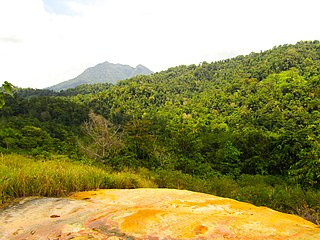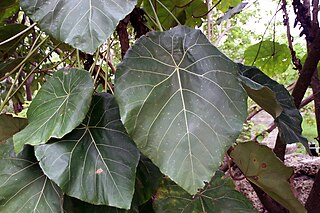
The four-horned antelope, or chousingha, is a small antelope found in India and Nepal. Its four horns distinguish it from most other bovids, which have two horns. The sole member of the genus Tetracerus, the species was first described by French zoologist Henri Marie Ducrotay de Blainville in 1816. Three subspecies are recognised. The four-horned antelope stands nearly 55–64 centimetres (22–25 in) at the shoulder and weighs nearly 17–22 kilograms (37–49 lb). Slender with thin legs and a short tail, the four-horned antelope has a yellowish brown to reddish coat. One pair of horns is located between the ears, and the other on the forehead. The posterior horns are always longer than the anterior horns, which might be mere fur-covered studs. While the posterior horns measure 8–12 centimetres (3.1–4.7 in), the anterior ones are 2–5 centimetres (0.79–1.97 in) long.

Bogani Nani Wartabone National Park is a 2,871 km2 (1,108 mi2) national park on Minahassa Peninsula on Sulawesi island, Indonesia. Formerly known as Dumoga Bone National Park, it was established in 1991 and was renamed in honour of Nani Wartabone, a local resistance fighter who drove the Japanese from Gorontalo during World War II. The park has been identified by Wildlife Conservation Society as the single most important site for the conservation of Sulawesi wildlife and is home to many species endemic to Sulawesi.

The plantain squirrel, oriental squirrel or tricoloured squirrel is a species of rodent in the family Sciuridae found in Indonesia, Malaysia, Singapore, and Thailand in a wide range of habitats: forests, mangroves, parks, gardens, and agricultural areas. Fruit farmers consider them to be pests.

The fourhorn sculpin is a species of ray-finned fish belonging to the family Cottidae, the typical sculpins. This species has a Holarctic distribution and can be found in marine, brackish and fresh waters.
Macaranga attenuata is a species of plant in the family Euphorbiaceae. It is endemic to the Society Islands of French Polynesia, where it is found on Moorea, Raiatea, and Tahiti.
Macaranga beillei is a large shrub or small tree in the family Euphorbiaceae. It is endemic to Côte d'Ivoire.
Macaranga bicolor is a species of plant in the family Euphorbiaceae. It is endemic to the Philippines.
Macaranga caudatifolia is a species of plant in the family Euphorbiaceae. It is endemic to the Philippines.
Macaranga congestiflora is a species of plant in the family Euphorbiaceae. It is endemic to the Philippines.
Macaranga conglomerata is a species of plant in the family Euphorbiaceae. It is found in Kenya and Tanzania. It is threatened by habitat loss.

Macaranga grandifolia is a species of flowering plant in the family Euphorbiaceae. Common names for this plant include nasturtium tree, parasol leaf tree and bingabing. It is endemic to the Philippines and has been widely cultivated in Hawaii as a tropical ornamental. This plant has become very popular garden ornamental in many parts of the tropics for the extraordinary grandiose leaves, which are rounded-ovate in shape, with prominent, reddish veins and the stem attached towards the center of the leaf blade. The flowers are pinkish red and the males are held in coral-like, congested inflorescences. Twine made from the bark and the wood was used for fishing spears. The leaves were used to wrap food. Birds eat the ripe fruit.
Macaranga huahineensis is a species of plant in the family Euphorbiaceae. It is a tree endemic to the island of Huahine in the Society Islands of French Polynesia.
Macaranga mauritiana is a species of plant in the family Euphorbiaceae. It is endemic to Mauritius.
Macaranga paxii is a species of plant in the family Euphorbiaceae. It is found in Cameroon and Nigeria. It is threatened by habitat loss.
Macaranga raivavaeensis is a species of plant in the family Euphorbiaceae. It is endemic the islands of Raivavae and Rimatara in the Tubuai Islands of French Polynesia.
Macaranga taitensis is a species of plant in the family Euphorbiaceae. It is a shrub or tree endemic to the island of Tahiti, in the Society Islands of French Polynesia.
Macaranga venosa is a species of plant in the family Euphorbiaceae. It is endemic to the Society Islands of French Polynesia, where it grows on the islands of Raiatea, Tahaa, and Tahiti.
As of July 2016, the International Union for Conservation of Nature (IUCN) lists 238 conservation dependent species. 0.29% of all evaluated species are listed as conservation dependent. The IUCN also lists seven subspecies and five varieties as conservation dependent.
Macaranga indica is a heliophilous evergreen plant native to South and Southeast Asia and China. A crimson colored resin called "macaranga gum" is obtained from this plant. Many parts of the plant are used for ayurvedic medicine in India and Sri Lanka.

Macaranga denticulata is a species of Asian small trees in the family Euphorbiaceae and tribe Acalypheae, found especially in secondary tropical forests. No subspecies are listed in the Catalogue of Life and the recorded distribution includes: the Indian subcontinent, southern China, Indo-China and western Malesia.






